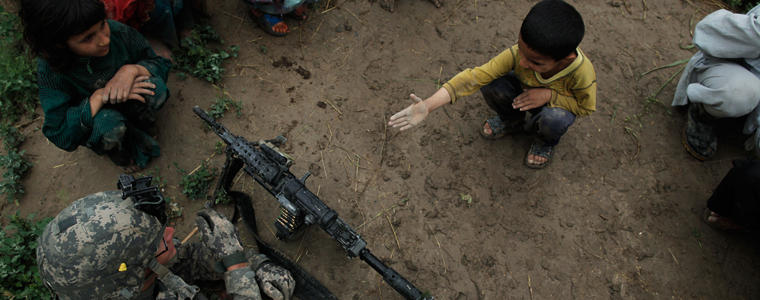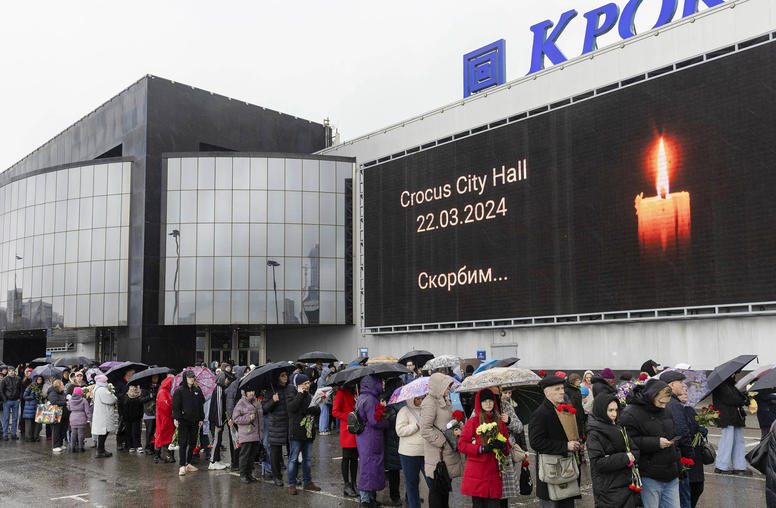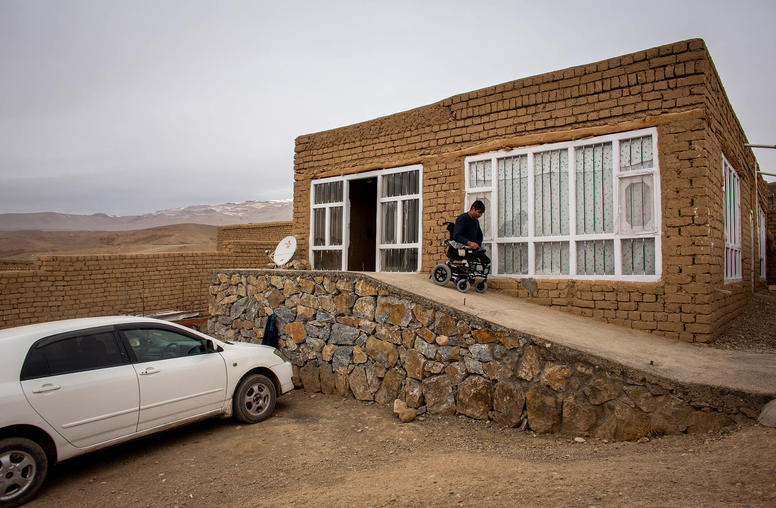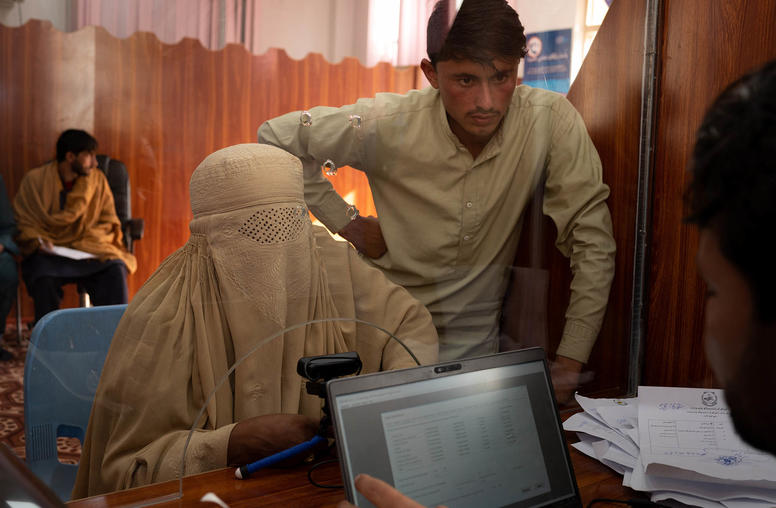The Value of Building Peace
We asked USIP leaders, from board members to senior staff and experts, to explain the effect that events around the world and here at home will have on the U.S., and the contributions the Institute can and does make during a time of tremendous challenge – and opportunity. USIP Chief Financial Officer Michael Graham describes the effect the federal budget crisis is having on the nation’s civilian agencies as very challenging. Graham believes that peacebuilding, by its very nature, saves money – and lives.

This past year has offered fresh proof that the world we live in is ever dynamic. Fundamental change can come from something as extraordinary as a fruit vendor’s act of defiance in Tunisia to popular revolts by reform movements across the Middle East. At the same time, a decade of war and the weak U.S. economy dictates that there must be new ways to think about the role the U.S. will play in the world in the coming years.
We asked USIP leaders, from board members to senior staff and experts, to explain the effect that events around the world and here at home will have on the U.S., and the contributions the Institute can and does make during a time of tremendous challenge – and opportunity. But there is also turmoil at home, as Congress grapples with a budget crisis and the American public grows weary of foreign intervention.
USIP Chief Financial Officer Michael Graham describes the effect the federal budget crisis is having on the nation’s civilian agencies as very challenging. But Graham believes that peacebuilding, by its very nature, saves money – and lives. The scramble to maintain the country’s ability to provide critical peacebuilding capabilities under persistent fiscal uncertainty wreaks havoc on peace and stability operations around the world, he says. “USIP and the peacebuilding community have had to make hard, painful decisions, because you cannot sustain what you cannot afford,” he says.
The U.S. has been engaged in intense and costly conflict for the last 10 years, and despite the drawdown of troops in Iraq and soon, Afghanistan, there is little light at the end of the tunnel when it comes to conflict. How would you describe the current tension between war and peace?
Maybe the idea of peace has changed, and not just in the last decade. As the distinction between conditions of “non-war” and war today seem to blur, it appears to affect what peace means to people. I come at this from Clausewitz’ view, that war is a continuation of policy by violent means. As a means, most agree it ought to be the least desirable, certainly for state actors. Sun Tzu shared that view. Neither imagined war as the principal means for achieving policy aims. Yet here we are today in the early 21st century and war still is a principal option, and war with unclear termination points and war seemingly without end seems to be the new norm. We have learned the hard way that the old notion of going to war, conquering an enemy, and walking away is no longer viable in a much more complex and interconnected and interdependent modern world.
Conflict, we are told, is part of the human condition. But there needs to be more depth to efforts to prevent it from becoming violent and wrecking economies. Certainly America can’t afford war after war financially, nor can our national identity and conscience afford it. The people who serve in our military and large number of civilians who support and enable them abroad are real people with real lives … they’re sons and daughters, brothers and sisters, husbands and wives, they’re moms and dads. These are the longest wars in the history of the republic with several tours of duty not uncommon. A generation is rising in America that has only known a nation at war. As the nation’s Founding Fathers understood, one of the great promises of democratic government especially is to do everything possible before sending its citizens off to fight wars from which many won’t return.
What is peacebuilding?
Peacebuilding describes the work it takes to prevent, manage or resolve violent conflict. It can come in any number of forms. It could be training a group in mediation or negotiation skills. Or maybe convening tribal leaders to discuss the issues over which they disagree. Maybe peacebuilding in another context is applying the lessons we’ve learned in other areas of conflict management to a new region. In all, peacebuilding is about providing people in overseas conflicts the tools they need to create or maintain international peace and stability.
Peacebuilding is recognized by those who contribute and count on it most in action—our military, diplomats, development experts and international, nongovernmental and humanitarian organizations. The practice uses communication, negotiation, and mediation from government to grassroots levels to reduce and eliminate the frequency and severity of violent conflict. It is incremental work to prevent or help end conflict. It is about equipping individuals on the ground in conflict zones with the operational tools and analytics they need to mediate with groups in conflict or negotiate a peace settlement. It takes time, but in the end it’s about saving lives and money.
Applying unified training, operations and applied research for whole-of-community peacebuilding in the national security context is what Congress created USIP to do. And it’s why Congress put the Secretaries of Defense and State and the military’s general or flag officer who leads the National Defense University on the USIP Board—to ensure a strong relationship with the Defense and State departments. Creating USIP is one of America’s great statements and achievements for peaceful relations among the planet’s people.
Can you give me an example of how USIP “professionalizes” peacebuilding?
America must have all options on the table to prevent and resolve war and conflict. USIP works quietly and effectively to help integrate peacebuilding and civilian-military operations and train foreign conflict managers to reduce the need for military interventions. The training emphasizes a professional whole-of-community approach to preventing, mediating and resolving conflicts. USIP has had peacebuilders on the ground in Afghanistan since the fall of the Taliban and in Iraq since 2003—three weeks after the invasion phase of the war ended. Several of our people have been killed in the line of service, and so have a number of partners. On any given day about one-third of USIP’s teams of professional peacebuilding trainers, peace operations specialists and analysts are actively engaged throughout the world helping prevent conflict in small ways and big ways. And when these operations are successful, the need for military intervention is reduced. An example is the Niger Delta in Africa. USIP reduced deadly conflict in this volatile, oil-rich, densely populated region between 2005 and 2008 by training religious and community leaders in conflict resolution, integrating former rebels back into their home communities, and negotiating proposals to resolve some of the key issues dividing the Nigerian government and the Niger Delta rebels.
In this budgetary environment in which conserving resources is key, why is peacebuilding cost-effective?
First, preventing conflict is a cost-effective national security strategy at any time, but particularly in a time of extreme fiscal restraint. That said, there is no magic formula to cutting international affairs funding that won’t at the same time undermine critical aspects of America’s contributions to international peace, security and stability—they’re all at stake. There is the turmoil in the Middle East where the Arab Spring uprisings have brought down entrenched authoritarian leaders but created instability and uncertainty. There remains doubt about stability in Iraq, since the U.S. military departed the country. And the turbulence in Afghanistan makes the course there perilous for the future. At the same time there is the threat of terrorism and nuclear proliferation with Iran and North Korea, and the need to hedge against China and Russia’s resurgence in the international system.
The conclusion in these situations is that preventing conflict in the first place saves lives, reduces the government’s costs and enhances national security. In general, the commitment of our military to any conflict constrains our nation’s strategic flexibility because we often commit so much of our resources to the conflict for an extended period of time. When we can resolve more conflicts without resorting to violence, we conserve our capabilities for those times when we really need it. There is no quick and easy fix to this problem, but it reinforces the need for more progress to develop alternative solutions for preventing conflicts from becoming violent.
How cost-effective is peacebuilding?
Armed conflict costs money—big money. The latest estimates are that America will spend more than $8 trillion in Afghanistan and Iraq. Defense Secretary Leon Panetta recently told a Senate panel that each soldier or Marine in Afghanistan costs the government $850,000 per year. In its 28-year history, USIP has paid for itself many times over. Where the Institute’s peacebuilding has helped mitigate or prevent conflict, it has saved billions of dollars. If you compare the cost of American military expenditures in Afghanistan, about $7 billion per month, one month would fund USIP for almost 300 years. The cost of just four hours of the war in Afghanistan would pay for global peacebuilding for a year. The defense budget would fund USIP’s peacebuilding efforts for more than 14,000 years. I’ve yet to meet a general or admiral who isn’t floored by that math.
Where has USIP’s work had an impact?
There are numerous examples of peacebuilding’s impact. As ongoing international peace operations increased and became longer, more intense and more complex than ever in the post 9/11 international environment, USIP put professional peacebuilding into practice. In that time, peacebuilding has contributed to conflict outcomes from Kosovo to the Philippines to Nigeria, Nepal, Iraq and Afghanistan to dozens of other conflict environments.
Another example is Sudan. Estimates were that a return to civil war in 2010 would cost hundreds of thousands of lives and cost the international community $30 billion or more in peacekeeping and humanitarian assistance. USIP conducted a series of meetings in which conflict managers were trained in strategies for preventing electoral and referendum violence. We helped them understand what the triggers of violence are and trained them in critical conflict management skills like negotiation and communication to help prevent conflict from becoming violent. The result of this particular training was the drafting of a code of conduct for local political party members who pledged not to use violence in two areas, Blue Nile and Khartoum. And despite ongoing challenges and sporadic violence, that community has remained stable. USIP’s intervention made a significant difference.
What has the USIP response been to the federal budget crisis?
The Institute’s leadership fully recognizes that it is always important to be adaptive, but especially now. USIP is aggressively doing its part in the prevailing federal budget environment. We are committed to making every dollar of funding the Institute receives count, and we are doing so across the organization. The result is a new breed of national security support: focused, agile and innovative operations—small footprint, high impact and partnership focused. Whatever your comparison, USIP’s mission is high impact at a very low cost. As all national security organizations are being forced to make hard choices about where to focus declining resources, USIP is taking strong measures to help get the nation’s fiscal house in order. The President’s fiscal year 2013 budget request of $37 million for USIP is almost 25 percent below FY 2010’s budget level. As a result, the workforce is 16 percent smaller, from 345 international conflict mediators, trainers, analysts and logistics experts to 289.
Very early on, our board and leadership did a front-end assessment. Developing the various scenarios helped us think through the "what ifs" and courses of action. It took governance, leadership and management working together to act progressively to sustain mission requirements instead of waiting to respond reactively in regressive ways. Therefore, we have been actively working to reduce costs primarily through prioritizing, streamlining operations and making investments in institutional capacity such as planning, evaluation and workforce development. We have focused intensively on eliminating program and administrative overlap, consolidating and reducing the number of senior positions, and employing an effective, leading edge management model emphasizing empowered mid-level managers. At the same time, USIP has not wavered from its core mission.
Is there anything else you’d like to add?
Peace doesn’t just happen. It’s something you have to work at, continuously, every day, at low levels and high levels and all the levels in between. Peacebuilding is hard work, and it takes patience. And when it’s done right, lives and dollars are saved. It’s hard to argue with that kind of effectiveness.



